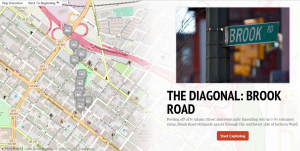
Matt takes in the view of Jackson Ward from his apartment’s front porch. (Photo and video below by Jack DeAngelis)
by Jack DeAngelis
I found Matt and Ben, two VCU students, sunning themselves on the front porch of their old apartment a block off Brook Road, on the west side of Jackson Ward. When I asked what it was like to live there, they both mentioned the number of bars and art galleries moving into their diagonally oriented neighborhood. Unlike most Richmond streets that run east-west or north-south, Brook Road is slanted.
“This is the lively part,” said Matt, gesturing at the streets nearby. He did seem aware of the area’s rough-and-tumble past. “It’s not the ghetto or anything,” he added.
For people like Matt—and there are a lot of them these days in Jackson Ward—Brook Road is the lively diagonal passthrough, harpooning the neighborhood’s changing identity. For them, the Jackson Ward beyond Brook existed in some other older or poorer world.
Many newcomers are putting down roots on the southwest side.
Here, crumbling brick buildings are trimmed with white wood and decorative lights dangling on wires. The front steps of a foreclosed apartment block lead to the same sidewalk occupied by tables at open-air restaurants. And the air’s lingering smell of marijuana is offset by the wholesome scene of women rugby players training in Abner Clay Park.
Eventually, moving north, half of Brook Road funnels onto an I-95 entrance ramp and is sucked up by the expressway. Before construction for the high-speed thoroughfare began in 1954, Brook continued north towards Virginia Union University.
Click the map below to walk Brook Road:
But today the other half of Brook peels off Chamberlayne and winds up in Gilpin Court, a world away from the trendy, up-and-coming diagonal that Matt described from his porch.

